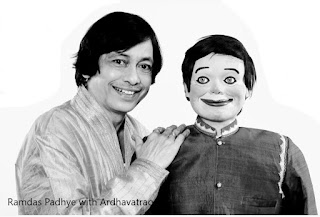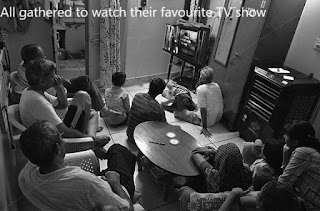Television came to Bombay on Gandhi Jayanti, 2nd October 1972. Inder Kumar Gujaral, who was then the I&B minister and later went on to become Prime Minister, made the inaugural speech launching a service that would connect, educate and entertain millions across our city and state. But in reality, it did much more than that. In today's lingo, TV became a disruptive medium. Because, though it was telecast only for a few hours every day, Bombayites began to adjust their daily routine according to the timings of their favourite shows which were produced by a division of Prasar Bharati known as Doordarshan.
The day's telecast would begin on weekdays at 6.00 pm with a signal bar chart followed by the Doordarshan logo that would come on to the screen with its signature tune playing in the background. The telecast was in Black and White.
The launch of Doordarshan spawned a new industry - the manufacture of Black & White TV sets, cables and aerials. The TVs were housed in a rectangular wooden box standing on four legs with folding or sliding doors protecting the screen, with speakers and a control panel on the side. And though most televisions had a knob to switch channels, the irony was there was only one channel available. As the viewership increased, advertisements for TV brands such as Standard, Televista, Telerad, Weston, JK Tv, Dynora, Crown and the government-owned ECTv became increasingly visible in the print media. But to own a TV set, one needed a licence that had to be renewed annually at the local post office. And, inspectors were doing the rounds to ensure that you did! The TV sets were connected by a flat co-axial cable to the aerials mounted on a pole on the roof or terrace. And every time there was image distortion on the screen, one had to go up and readjust the aerial whilst someone else had to co-ordinate from below, often leaning dangerously out of the window. It was a chore that we now remember as fond memories but was quite annoying then. Another option was the indoor V-shaped antenna which was usually placed on the TV cabinet.

Despite all the shortcomings in the early days, TV became a popular source of entertainment. The telecast was a mix of educational, social and entertainment programmes with something for everyone in the family. For children, there was Magic Lamp in English, Kilbil in Marathi, Santakukdi in Gujarati and Khel Khilone anchored by the effervescent Manju Singh in Hindi. The children enjoyed quiz, arts & crafts, puppetry and ofcourse, the stories narrated on these shows. Besides these, there were English serials - Fireball XL5, Invisible Man, Man In A Suitcase, Count Of Monte Cristo, Sir Francis Drake, Here's Lucy, Charlie Chaplin, Nicholas Nickelby, Father Dear Father and the universally popular German games show, Tele-Match. Ventriloquist and puppeteer Ramdas Padhye added to the merriment with his 'friend-in-arms' Ardhvatrao in Meri Bhi Suno.

Cartoons such as Flintstones and those by the Films Division were also fun to watch. Stop Pull Chain, Skin in the Bin, Tree of Unity, etc., were produced by Films Division to spread a social message in a fun way. Though the quality of animation was below par as compared to Walt Disney cartoons, they did make their point.
Chaya Geet, a medley of Hindi movie songs was telecast on Thursdays whilst the effervescent Tabassum conversed with Hindi film personalities in Phool Khile Hai Gulshan Gulshan on Fridays. Both these programs were aired at 9.10 pm. Saturday evenings were reserved for regional movies and plays, usually in Marathi and occasionally in other languages such as Gujarati and Sindhi. However, the most awaited program of the week was the Hindi movie on Sunday evening. Before the advent of the VCR, this was the only way one could watch a movie outside a theater. Such was the popularity of these programs that those who did not own a TV set would visit a neighbour, friend or relative to watch their favourite show. It was common to see many people huddled in the drawing rooms of those fortunate enough to own a TV set, especially on a Sunday evening to watch the Hindi movie.

Before we had the very popular Hum Log in the 80s, we had Chimanrao, a Marathi serial starring Dileep Prabhavalkar and Bal Karve. It was written by humourist Chintanman Joshi and it regaled audiences across language barriers. It continues to be popular even today and is widely watched on YouTube. Sunday mornings had us laugh at the witty conversation between Babban Prabhu and Yakub Sayeed in Haas Parihas. Another popular Marathi program was Gajra which was telecast weekly. It was produced by Vinayak Chaskar and presented humourous skits and light-hearted interviews. The Diwali episode of Gajra was always a special treat. Sundar Maaze Ghar hosted by Suhasini Mulgaonkar was a 'Ladies Special' offering home improvement tips whilst in Pratibha Aani Pratima personalities from the field of Arts, Literature & Culture were interviewed giving an insight into their contribution to society.

Besides entertainment, Doordarshan also had social responsibilities to fulfil. And two shows that did just that were Amchi Maati Amchi Maansa and Kamgar Vishwa. The first gave valuable farming-related inputs to farmers and the other took up labour-related issues. Many may not be aware that Doordarshan also launched Education Tv or E-Tv, a program aimed at students studying in Municipal and Government schools. It was telecast in the mornings and afternoons on weekdays. This project was a joint venture between ISRO & NASA and was known as Satelite Instructional Television Experiment or SITE. But probably the most remembered program must surely be "Aapan Yaannaa Pahilat Kaa?"! It showed pictures of missing people whilst describing their physical details and last seen location. It often made viewers wonder if they had recently seen 'that' face somewhere.

Somewhat similar to Pratibha Ani Pratima was Parikrama, a talk show in Hindi hosted by Kamleshwar. Besides being a show host, Kamleshwar was also an author, screenplay writer and critic. In Parikrama, he interviewed a wide cross-section of people from diverse fields on current topics. Whilst Parikrama was wide in its scope, Aapka Swasthya hosted by Dr. Padam Singhvi focussed on different medical conditions and their treatment. For those interested in being healthy the natural way there was Dhirendra Bhramachari's Yogabhyas in which two of his pupils would demonstrate various yoga poses whilst he would explain their health benefits.
Adi Marzban, a doyen of Bombay Theatre produced the immensely popular Gujarati show Aavo Mari Sathe. Like Gajra in Marathi, it presented Gujarati singers, musicians as well as humourous skits featuring well-known stage artists like Dinyar Contractor, Adi Pocha and Kishore Bhatt, a.k.a Karsankaka. Besides Avo Mari Sathe, Adi Murzban also introduced What's the Good Word, a word-guessing game show with Gautam Vohra as host. It was telecast on Saturdays at 9.10 pm. Later, it was Sabira Merchant who went on to become the popular face of the show for the next two decades.
Some other programs in Gujarati were Parijaat, Mauj Majha, Gher Betha and Yuvadarshan, the last being telecast in Hindi and Marathi as well. For music lovers, there was Sugam Sangeet. Other musical programs were Shabdanche Palikade in Marathi and Sham-e-Gazal in Urdu.
For sports lovers, there was Fredun de Vitre's Sports Roundup and AFS 'Bobby' Talyarkhan's Looking Forward, Looking Back. Talyarkhan used to deliver his bland monologue with a poker face facing a fixed camera. In the absence of live relays of most sports tournaments, both these shows analysed the recent outings of Indian sportsmen. Cricket, however, was an exception. Doordarshan brought home Cricket Test matches by broadcasting them, usually live when they were played in India. The first match telecast was the 1974 series against England, followed by one against the mighty West Indies. Later in July 1976 viewers saw Nadia Comaneci score a perfect 10 in gymnastics at the Summer Olympics in Montreal.
Besides cricketing updates, Doordarshan featured daily 10 minute news in Marathi, Hindi and English. Marathi news or Batmya was telecast at 7.30 pm and was read by Pradeep Bhide or Bhakti Barve, Anant Bhave, Charushila Patwardhan, Smita Talwalkar and later, Smita Patil. Hindi Samachar came in at 9.00 pm and was presented by, amonst others, Sarita Sethi, Kumud Merani and Harish Bhimani. At the close of the day was News in English at 10 pm with Luku Sanyal, Dolly Thakore, Gerson DaCunha, Nirmala Matthan and Pratap Sharma giving the last dispatch before we went to bed. Some of the Marathi newsreaders were also the face of Udyache Karyekram and Saptahiki which gave a preview of what would be telecast the next day and over the coming week. As newsreaders, they became household names although some of them were already in the public eye due to their association with the theatre.
Though it was a monopoly service, Doordarshan did make an effort to feel the viewer's pulse. There were shows in Hindi, Marathi and Gujarati, where viewers' letters were read out and replies given. T P Jain and Sudha Chopra hosted the Hindi version which was titled Aap Ki Rai whilst J B Desai and Jyoti Vyas hosted the Gujarati version, Aapne Sambhodhine.
Advertisements on Doordarshan initially were still images with a voiceover. Ads for Forhan's Toothpaste, Bournvita, Digjam Suitings, Binaca Floride, Mysore Sandal Soap were some of the few that appeared early on. Later, HMT Watches, Complan, Thums Up, Liril film ads started appearing on TV.
With Delhi hosting the Asian Games in November 1982, a decade after Doordarshan Kendra Bombay's inaugural show, colour finally arrived on the small screen. With that, the golden era of black-and-white television that regaled us with wholesome entertainment came to an end. With the arrival of colour, and later more channels, viewers could now watch a variety of programs as well as the live telecast of events throughout the day and most importantly, get news that was not government-censored.
With inputs from Ms. Nita Parekh, ex-producer Doordarshan Kendra, Mumbai.








Great article. I was not much aware of 70's doordarshan and now I am!
ReplyDelete